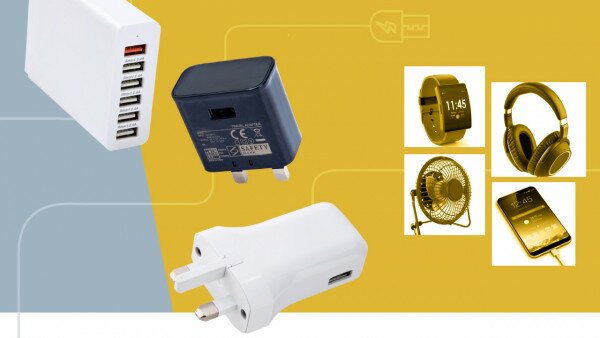Mobile devices are proliferating in ever more variety – handsets, tablets, and even portable fans, and they all need to be charged up at any time. In addition to the original USB charger that supplied with the product, many consumers also purchase other USB chargers for their own use like in the workplaces. In collaboration with the Electrical and Mechanical Services Department (EMSD), the Consumer Council has conducted a test on various models of USB chargers in the market. The test uncovered 2 USB charger models to fail in some areas of safety compliance. One was found with deficiency in 2 areas – inadequate clearance and resistance of the outer cover materials to heat, to which consumers should pay attention while purchasing.
The test covered 16 USB charger models ranging in price from $49 and $338. 9 of the models are equipped with quick charge function and all are equipped with the common USB Type-A sockets requiring only a USB cord connection to activate charging. In the test, the models were rated for their safety, energy efficiency, compatibility, and convenience of use.
The top performers in overall rating, with 5 points in full, turned out to be 2 medium-priced USB charger models at $180 and $219 respectively. The least ($49) and most ($338) expensive USB charger models also scored well with 4.5 points, but their prices vary considerably to around 6 times, indicating that price differentials do not necessarily bear any direct correlation with the product quality.
As USB chargers are put to frequent usage, and prolonged connection to power supply, there will be increased risks of home accidents if using faulty charging devices. Safety tests, conducted with reference to IEC 60950-1, revealed 2 USB charger models to be unsatisfactory in their resistance to heat and flame in the outer cover materials. In 1 model it was put through high temperature of 104oC for 7 hours; afterwards its plastic enclosure was found deformed and the internal live parts could be touched by finger. In another, the model failed in the flammability test, with the outer cover continued to burn for more than 1 minute after a flame was applied to it for 30 seconds.
Apart from inadequate resistance of the outer cover materials to heat, the model in question was also found with inadequate clearance between the live part and the exposed output terminal at only 4.2 mm, falling short of the standard lower limit of 4.9 mm. This product has to improve its safety quality.
In respect of marking and instructions, only 1 model came close to full product information provision; the remainder 15 models were less than adequate. Most were lacking in instruction manuals or symbol information, with nearly half of the models without such vital product information as input current, output voltage, Class II symbol and/or fuse information, etc.
The test on energy savings was conducted with reference to US Department of Energy’s Energy Conservation Standards for External Power Supplies, to assess the energy efficiency and no-load power consumption of the models. It showed that most models could achieve the standard efficiency, while the 1 model rated with the top mark of 5 points its efficiency was even higher than the standard requirement by 9%. 3 other models were measured with an average efficiency slightly lower than the standard requirement. One other USB charger its measured no-load power consumption was slightly higher than the limit, indicating that the charger could run up more electricity when in standby mode.
Furthermore, most models are equipped with multiple output terminals or quick charge function to allow charging multi-devices simultaneously or reduce the charging time. The test found most models to have good compatibility; but one model was unable to charge 4 mobile devices simultaneously most of the time, in contrary to what it claimed. Another 1 model while charging 3 mobile devices simultaneously was found incompatible with some brands of mobile phones as the total output current was not strong enough.
Among the 9 USB charger models with quick charge function, the USB chargers of 3 handset brands mainly support their own mobile devices, causing limitations on usage. When such a USB charger was tested on a handset brand other than its own brand, even the icon displayed the quick charging was on, there was actually no output current. Consumers are advised to take heed of this shortcoming.
USB chargers are more or less similar in design but they differ in their individual accessories. For instance, 5 models with single output terminal and retractable earthing plug pin with valves are convenient for the consumers to carry them around. Most of the models with multiple output terminals are fitted with power cords providing more flexibility in usage. In contrast, the power supply indication lights of 2 models are too small to draw the attention of consumers; some models also have wordings printed on them which the contrast to the colour of the charger is not obvious, making them very difficult to read.
Consumers using USB chargers are urged to pay particular attention to the following safety tips:
- Choose USB chargers with detailed marking and instructions, for instance, the name of the manufacturer, model number, input voltage and power, output power and current, etc.;
- Different mobile electronic devices may require different charging currents, so when buying additional USB chargers, refer to the original USB charger for the rated output current;
- Should the USB charger overheats or takes an unusual long time for charging, this may indicate that the USB charger is overloaded necessitating a switch to a USB charger with a higher output current;
- When charging is completed, cut off or disconnect the charger plug from the power supply.
The Consumer Council reserves all its right (including copyright) in respect of CHOICE magazine and Online CHOICE.



